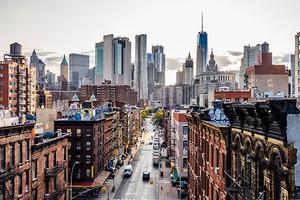On Campus
Do-it-Yourself Urbanism: What It Means for Cities, Planners, and Citizens

Tired of waiting for city officials to paint in a bike lane or beautify a vacant lot, some citizens are making improvements on their own.
The impact “do-it-yourself urbanism” has on planning and policy was the focus of a lecture by Gordon Douglas, assistant professor for Urban and Regional Planning at San Jose State University, hosted by AU School of Public Affairs' Metropolitan Policy Center recently.
Douglas talked about the growing trend of activism, whereby residents make unauthorized yet functional and civic-minded alterations to the urban streetscape. In his remarks, he cited research from his book, The Help-Yourself City: Legitimacy and Inequity in DIY Urbanism (Oxford University Press, 2018)
“Do-it-yourselfers see themselves as providing positive, creative, common-sense solutions in response to uneven development,” Douglas said during the spring lecture series event at the Metropolitan Policy Center (MPC). “It holds promise in helping people shape their own communities and show cities what people want.”
Douglas spent four years researching 75 urban-design projects in New York, Los Angeles, and 15 other North American cities and conducting more than 100 interviews with community members and professionals. He chronicled grassroots efforts to make homemade street signs, convert phone booths into book shelves, and turn parking spaces into “parkets” with grass and benches.
Those who embraced this type of activity were typically white, middle-class men with some college education who worked in creative professions, often with training in design or planning, Douglas discovered. They often researched their projects in advance and approached them with a degree of seriousness to get it right, so officials would not quickly take them down.
Douglas said some, however, created problems when they removed signage, such as at a bus stop, in an effort to reduce trash. Efforts to gentrify were not always viewed positively by long-term residents, and controversies have emerged when some do-it-yourselfers tried to impose changes outside their own neighborhoods.
“We can’t just embrace these tactics without an eye on the social equality,” said Douglas. Before building a new place, activists should acknowledge what exists and the value it may have to locals, he said. Some city planners quietly admire the DIY projects, but they also mentioned concern about safety and maintenance to Douglas during his research interviews.
SPA Associate Professor Derek Hyra, founding director of MPC, said Douglas’ comments highlighted civic engagement and informal political participation. “The Metropolitan Policy Center tries to bring together interdisciplinary thinking to promote greater democracy and improved public policy,” Hyra said. “I think the talk was the intersection of public administration and urban planning. Gordon did a great job of bringing those two perspectives together.”
